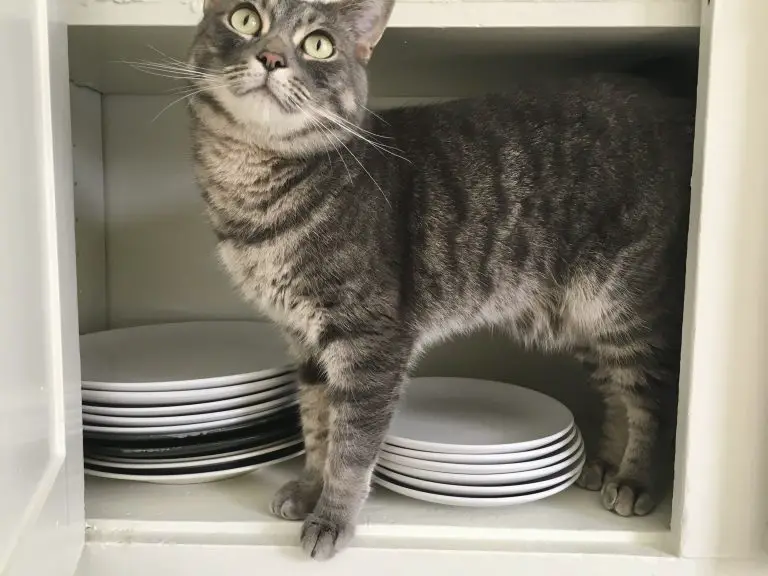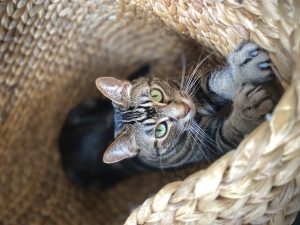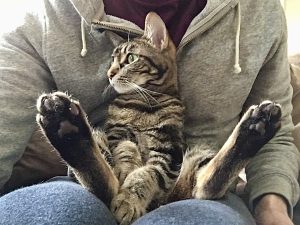Responsibilities of Cat Ownership – A Comprehensive Guide
If you’re thinking about getting a cat, you need to know what you’re signing up for before you decide. There are sooo many great reasons to have a cat, but there are quite a few downsides that are part of the package.
This article breaks down all the responsibilities that come with cat companionship.

Having a Cat is a Lot of Responsibility
While cats might generally be considered to be lower maintenance pets compared to dogs, they are a lot of work all the same.
That’s because cats are completely dependent on us for meeting their basic health and safety needs. This means providing nutrition, shelter, medical care, a clean environment, exercise, and companionship.
Responsible cat ownership requires not only money and time, but also learning, planning, and flexibility, as well as cooperation with family members or housemates.
And, cats often live for 15-20 years, so you need to be in it for the long haul. Before we get into the details, here’s a table summarizing what’s involved in caring for a cat, and how frequently each task is typically required.
Table: Cat-related responsibilities and their frequency
| Responsibility | Frequency |
|---|---|
| Play, interact, snuggle | Daily |
| Health Monitoring | Daily |
| Feed | Two or three times daily |
| Scoop/empty litter box | Daily or a few times per week |
| Refresh/fill water | Daily (or get a fountain) |
| Clean food bowls | Daily or a few times per week |
| Vacuum | Weekly |
| Clean up hairballs | Varies by cat, hairballs are more frequent for long-hair |
| Clean up destruction zones | Varies according to your cat’s levels of enthusiasm and creativity! |
| Groom: Brush fur | Daily to a few times per week. Depends on the season (frequent in summer) and type of coat (more for long-hair) |
| Groom: Trim claws | Every couple of weeks |
| Clean/wash Litter box | Every couple of weeks |
| Buy litter and food | Varies. Typically weekly or monthly |
| Wellness check-up with vet | Annually |
| Respond to health or emergency needs | As needed – likelihood increases for outdoor and elderly cats |
| *Buy and apply flea treatment | For outdoor cats, as often as monthly |
| Buy toys | Every once in a while |
| *Pay vet bills | Annually at minimum |
| Pay insurance bills, if you choose to carry insurance | Monthly or annually |
| Buy replacement items | As needed. Things like scratching posts, toys, and litter boxes wear out or break |
| Arrange for cat care when out of town | Every time you’re out of town |
| Cat-proof your home and maintain safe environment | Before you bring a new cat home and ongoing as necessary |
| Spay/Neuter and microchip | One time when you first get your cat |
General Expenses
Being a responsible cat owner costs a fair amount of money. Before you get a cat, you need to understand the details of what having a cat costs, and plan a monthly and annual budget for it.
This will help you be sure you can actually afford to have a cat, and know what to expect in terms of regular and potential surprise expenses.
Expenses can vary a lot, but here’s an example of typical costs if you buy more budget-friendly stuff.
Example Budget for One Cat
Basics up front to Get Started: >$400
Food, Litter, and Treats: $70 per month
Annual Vet Checkup: $100-$200 per year
Cat Furniture & Toys: varies, can be $0 some years
Cost of care when you’re out of town: $25-$30 per day
Unexpected health issues: $???
Optional pet Insurance: $25 per month
Emergency Fund to keep in savings at all times: >$1,000
Vet and Health Care
Having a cat will involve taking your cat to the vet annually and when needed. In addition to the up-front vet visit items (spay/neuter, microchipping, vaccinations), ongoing vet related care will include:
- Vaccinations
- Annual wellness checkups
- Consulting with your vet when concerns or problems crop up
- The constant possibility of health problems or accidents that require a trip to the vet. Chances of this increase for outdoor cats and as all cats age.
- Parasite control (if necessary)
Getting off to a Good Start and Socializing
Before you bring a new cat home, you need to prepare a space so that she can adjust to the new environment slowly while minimizing stress. You’ll also need to make a plan for how to introduce her to people and other pets.
It’s important to learn how to do this well, because these things set the stage for bonding and developing trust. And that’s critical to raising a confident and friendly cat.
Acclimating a cat to a new home often requires baby steps in the beginning.
Nutrition
Of course, you will also need to provide the nutrition your cat needs every day. Cats are carnivores and require a meat-based diet in order to survive.
Most people feed their cat twice a day, roughly 12 hours apart. It is important to follow nutrition and portion guidelines so that your cat stays healthy and maintains a healthy weight.
Providing an Appropriate Environment
There’s a lot that goes into providing an environment that’s appropriate for a cat. First, you need to cat-proof your home to keep your cat and your belongings safe, and you should do this before you bring your new cat home.
You also need to decide ahead of time whether or not your cat will spend any time outdoors, and if so, what that will actually look like. Many cat advocacy organizations recommend keeping cats as indoors-only pets, for the following reasons:
- Indoor cats are far less likely to get injured or die prematurely in an accident compared to outdoor cats. I have heard far too many stories of people’s cats being run over by a car or eaten by a coyote.
- Outdoor cats are also subject to conflicts with other cats that can lead to injuries. And there’s always the risk of your cat not coming home one night and never knowing what happened.
- Indoor cats tend to be healthier than outdoor cats, because the risks to health are so much lower. Healthier means fewer and lower vet bills.
- Indoor cats tend to need less treatment for fleas and parasites.
I have always chosen to keep my cats as indoors-only pets. The only exception to this is that I do let Gandalf outside occasionally, but I have taken the time to train him to stay close to me. I only let him out when I’m hanging out on my porch to make sure he doesn’t wander off.
If your cat goes out during the day, it will also probably mean that you’ll have the task of calling him in before dark each day. And this can occasionally be time-consuming or stressful if she doesn’t come running right away.
Cleaning
Having a cat can add to your household chores. I don’t mind this most of the time, and actually find that it gives me an excuse to clean the whole house a little more often than I otherwise might.
Here’s a detailed look at what you can expect in terms of cat-related cleaning chores:
- Litterbox at least a few times per week.
- Food and water dishes at least a few times per week.
- The floor around the litterbox every day.
- Barf or hairballs coughed up on the floor and other surfaces. Frequency will vary by cat, but can be a regular occurrence.
- Cat hair on your clothing and pretty much everywhere your cat goes in the house. Cat hair will be most concentrated where your cat sleeps or lounges. You’ll want to invest in a good vacuum.
- Bits of cardboard from scratchers. You’ll find these piling up around the base of scratchers as your cat uses them every day. These bits will get tracked around the house if you don’t vacuum them up regularly – at least once per week.
- Random messes created by your curious, hungry, or rambunctious cat – as frequent as daily.
- And of course there’s the issue of your own habits and cleaning up after yourself. You’ll probably have to modify some of your behaviors on a daily basis in order to prevent messes and dangers to your cat and your stuff.
Food Bowls
Food and water bowls need to be cleaned several times per week, varying according to preference and the type of food you’re feeding. I have 3 sets of bowls for my cats, so that I can change them out frequently and wash them in the dishwasher.
Litter Box
This is among the more unpleasant duties of cat care. The frequency you clean the litterbox will vary in part by preference, and in part by the type of litter you use.
I use a clumping clay litter, and tend to wait until it gets dirty enough to change out the whole thing. But some people like to scoop every day or every other day, adding small amounts of new litter back in each time to keep things fresh.
It’s worth investing in a quality litterbox and scoop, and doing your homework on what type of litter works best for you and your cat.
You’re advised not to slack here. If you’re lazy about litterbox maintenance, you may end up with pee outside the litterbox.
Sweeping
Especially near the litterbox, because all litter tends to track at least a little bit in a cat’s paws as they walk away from the litterbox after each use.
Some cats are very enthusiastic diggers, and may end up throwing litter over the litterbox walls. Gandalf is one of those cats. This is where choosing the right kind of litterbox can pay off.
Vacuuming
Cats shed, so you may find yourself needing to vacuum more frequently. This is especially true for your cat’s favorite sleeping spots, which may include the sofa or your bed. You’ll want a vacuum with a hand-held attachment.
Laundry
Cat bedding can get hairy and grimy over time. Frequency of cleaning will vary depending on how often your cat sleeps in each spot.
Spot Cleaning Hairballs and Cat Barf
Ah yes, everyone’s favorite part of cat ownership – the mystery of where you might find cat barf next. And whether you’ll find it with your eyes, or your bare foot!
Hopefully you end up with a cat that doesn’t barf super often, but you should know that it’s part of the deal no matter what. Same goes for hairballs, though this tends to be more frequent for long-haired cats.
Grooming
One really nice thing about cats is that they are meticulous about keeping themselves clean. This means cats typically require far less grooming care than a lot of dogs. But some maintenance is still required.
Brushing
Cats need to be brushed regularly. The frequency will depend on a few things. If yours is a long-haired cat, more frequent brushings will be necessary. Frequency will also increase for most cats in the summer, when they tend to shed a lot more.
Bonuses that come with Regular Brushing:
- Less cat hair to vacuum
- Fewer coughed up hairballs to step in or wipe up
Claw Trimming
Cats also need to have their claws trimmed regularly to maintain paw health. Get your cat used to this as early as possible so that it isn’t a struggle. I trim my cats’ claws roughly every couple of weeks.
If you neglect claw trimming duty, your cat may end up with a claw that grows straight into the paw pad. And that will probably mean a trip to the vet and an expense that could have easily been avoided.
Bonuses that come with Regular Claw Trimming:
- Reduces claw snags in your clothes when you hold or snuggle your cat
- If your cat likes to knead ON you like one of mine does, this will be more comfortable for you if your cat’s claws aren’t razor-sharp
- Reduces getting cuts on your hands and arms when playing with your cat
Spending Time and Interacting
Cats are more independent and less demanding of time than are dogs (read our article on why cats make better cats than dogs). But this doesn’t mean it’s fine for them if you’re never home. They need care, attention, and interaction from you or others in your home every day.
If you travel, you will need to arrange (and probably pay) for someone to look in on them twice a day, or find a place that boards cats if you have to. Just remember that change is stressful for cats – both change in routine, and especially in their environment (i.e., like being taken to a boarding facility).
Training and Learning About Cat Behavior
Yes. Although cats don’t require the amount of training dogs often do, taking the time to learn about cat behavior and training dos and don’ts is important.
It will allow you to respond appropriately and effectively to undesirable behaviors, and even prevent some from occurring in the first place.
You can also train cats to do some pretty cool stuff, like going for a walk with you, fetching, and responding to their name and other voice commands or signals. My cats come when called, and will perform a trick at mealtime.
In short, learning, researching, and some form of training will be a regular part of cat ownership. I have found that it’s really fun to learn about and develop my skills and knowledge.
Be Ready to Deal With Whatever Comes Up – the Good, the Bad, and the Unexpected
As I’ve already mentioned, having a cat comes with some downsides. Cats can be demanding or annoying at times, and they will inevitably do things you don’t want them to do.
Cat ownership requires patience, flexibility, kindness, compassion, and a willingness to learn and troubleshoot as you go.
If your cat gets injured or develops health problems, your costs of having a cat may go up.
Your cat’s needs will also change with age. You may have to increase your budget or make special accommodations in order to maintain proper care.
And of course, your cat will grow old. You will have to say goodbye one day – something that will likely be very difficult and sad when that time comes.
How Much Time Does it Take to Care for a Cat?
At the beginning of this article, we provided an overview of all the responsibilities involved in having a cat, and how frequently they’re typically required. Now let’s take that list and look at some rough estimates of how much time is required to do each of those things.
The amount of time it takes you for cat care will vary according to your circumstances, but you should expect to devote somewhere between 20 minutes to an hour each day.
Table: How Much Time Does it Take to Take Care of a Cat?
| Responsibility | Frequency |
|---|---|
| Play, interact, snuggle, bond | 5-15 minutes at least a few times per day |
| Health Monitoring | Part of daily interaction |
| Feed | 5-10 minutes twice per day |
| Scoop/empty litter box and sweep | 5-10 minutes per day |
| Clean litter box | 10-15 minutes twice per month |
| Clean food/water bowls | 5-10 minutes per week |
| Vacuum | 15-20 minutes per week |
| Clean up hairballs or barf | 0-5 minutes per week |
| Clean up destruction zones | 5-15 minutes per week |
| Groom: Brush fur | 10-20 minutes per week |
| Groom: Trim claws | 5-10 minutes every two weeks |
| Buy litter and food | 10-30+ minutes per month, depending on whether you buy locally or online |
| Wellness check-up with vet | A few hours per year |
| Respond to health or emergency needs | Varies. 0 to several hours per year |
| *Buy and apply flea treatment | 15 minutes per month if treatments are needed |
| Additional miscellaneous chores | Varies widely |
Last Meows
Now you should have a good sense of the responsibilities and the kinds of tasks involved in having a cat. It definitely takes money, time, and work.
But if you’re ready to take it on, it’s all more than worth it. Because of course, there are just so many upsides to cat ownership, so make sure you read up on those too!

